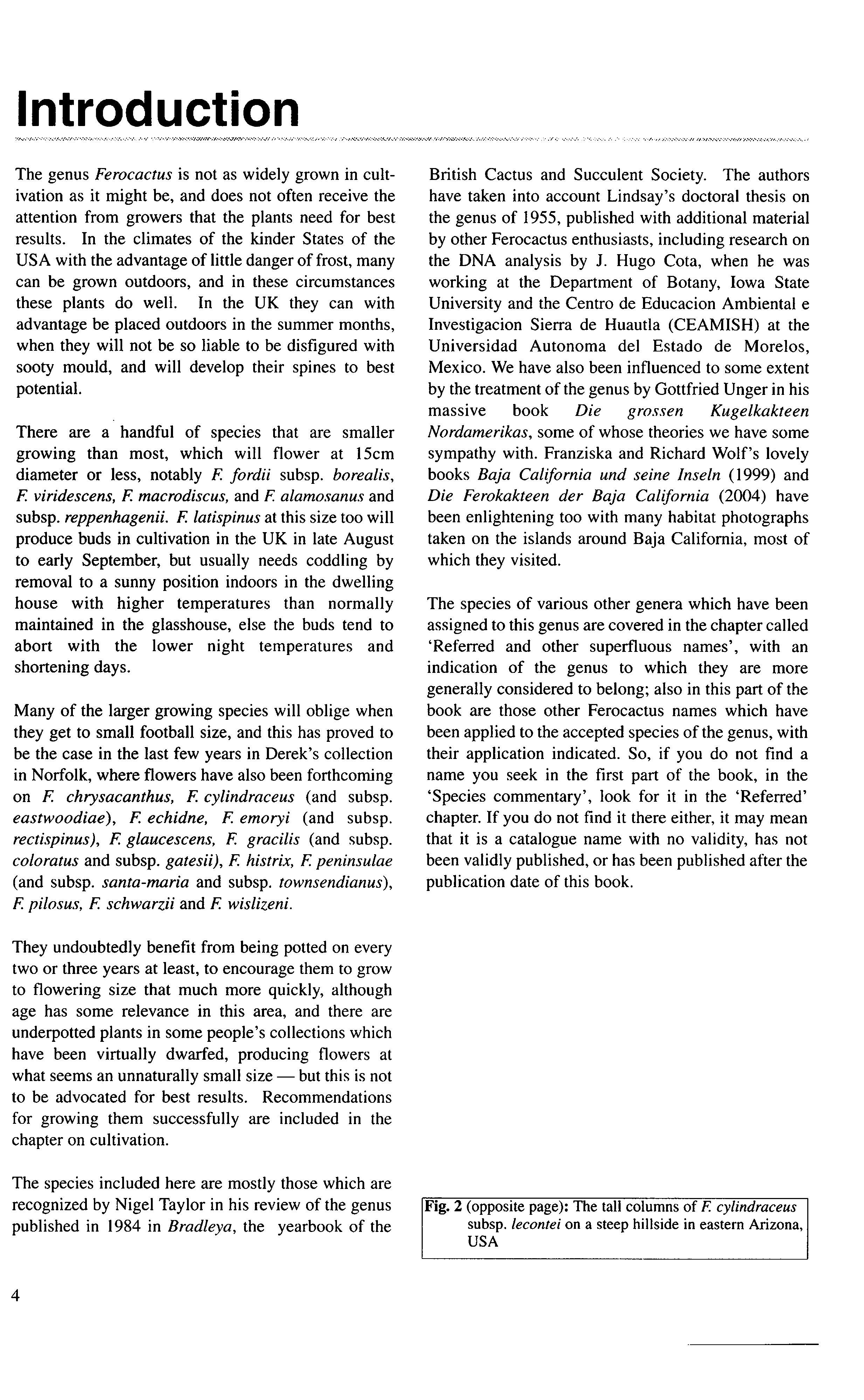
16 minute read
Introduction
from Ferocactus
by Ammar
The genus Ferocactus is not as widely grown in cultivation as it might be, and does not often receive the attention from growers that the plants need for best results. In the climates of the kinder States of the USA with the advantage of little danger of frost, many can be grown outdoors, and in these circumstances these plants do well. In the UK they can with advantage be placed outdoors in the summer months, when they will not be so liable to be disfigured with sooty mould, and will develop their spines to best potential.
There are a handful of species that are smaller growing than most, which will flower at 15cm diameter or less, notably F. fordii subsp. borealis, F. viridescens, F. macrodiscus, and F. alamosanus and subsp. reppenhagenii. F. latispinus at this size too will produce buds in cultivation in the UK in late August to early September, but usually needs coddling by removal to a sunny position indoors in the dwelling house with higher temperatures than normally maintained in the glasshouse, else the buds tend to abort with the lower night temperatures and shortening days.
Advertisement
Many of the larger growing species will oblige when they get to small football size, and this has proved to be the case in the last few years in Derek's collection in Norfolk, where flowers have also been forthcoming on F. chrysacanthus, F. cylindraceus (and subsp. eastwoodiae), F. echidne, F. emoryi (and subsp. rectispinus), F. glaucescens, F. gracilis (and subsp. coloratus and subsp. gatesii), F. histrix, F. peninsulae (and subsp. santa-maria and subsp. townsendianus), F. pilosus, F. schwarzii and F. wislizeni.
They undoubtedly benefit from being potted on every two or three years at least, to encourage them to grow to flowering size that much more quickly, although age has some relevance in this area, and there are underpotted plants in some people's collections which have been virtually dwarfed, producing flowers at what seems an unnaturally small size - but this is not to be advocated for best results. Recommendations for growing them successfully are included in the chapter on cultivation.
The species included here are mostly those which are recognized by Nigel Taylor in his review of the genus published in 1984 in Bradleya, the yearbook of the British Cactus and Succulent Society. The authors have taken into account Lindsay's doctoral thesis on the genus of 1955, published with additional material by other Ferocactus enthusiasts, including research on the DNA analysis by J. Hugo Cota, when he was working at the Department of Botany, Iowa State University and the Centro de Educacion Ambiental e Investigacion Sierra de Huautla (CEAMISH) at the Universidad Autonoma del Estado de Morelos, Mexico. We have also been influenced to some extent by the treatment of the genus by Gottfried Unger in his massive book Die grossen Kugelkakteen Nordamerikas, some of whose theories we have some sympathy with. Franziska and Richard Wolf's lovely books Baja California und seine Inseln (1999) and Die Ferokakteen der Baja California (2004) have been enlightening too with many habitat photographs taken on the islands around Baja California, most of which they visited.
The species of various other genera which have been assigned to this genus are covered in the chapter called 'Referred and other superfluous names', with an indication of the genus to which they are more generally considered to belong; also in this part of the book are those other Ferocactus names which have been applied to the accepted species of the genus, with their application indicated. So, if you do not find a name you seek in the first part of the book, in the 'Species commentary', look for it in the 'Referred' chapter. If you do not find it there either, it may mean that it is a catalogue name with no validity, has not been validly published, or has been published after the publication date of this book.
Fig. 2 (opposite page): The tall columns of F. cylindraceus subsp. lecontei on a steep hillside in eastern Arizona, USA
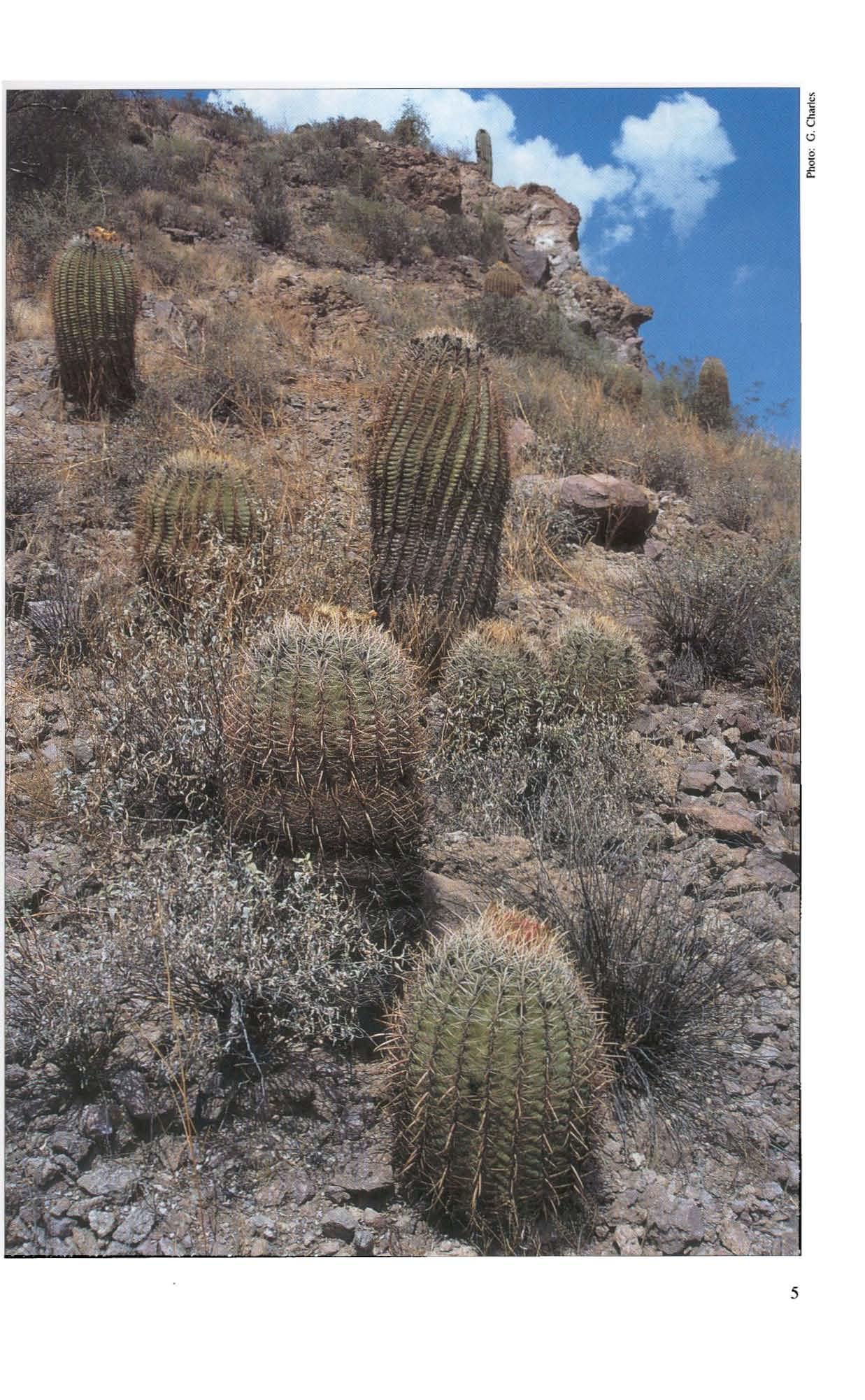
Classification
The genus was set up by Britton and Rose in their classic work The Cactaceae, published in four volumes between 1919 and 1923. Ferocactus is covered in volume 3 from page 123 to 147. Of particular interest are three photographs including people of the time: figure 143 seems to be of a young boy behind a large clump of F. robustus, which looks suspiciously like the one featured in this book; figure 153b is a photograph of F. rostii (F. cylindraceus) taken by E. C. Rost, and including a moustachioed, elderly man, a good foot shorter than the plant, standing questioningly by it with a pick as if to say "You don't really mean that you want me to dig this one out?". But the best is one taken by Dr. MacDougal in 1903 of a man drinking from his cupped hands liquid obtained from a beheaded Ferocactus, illustrating graphically the information in the text on the previous page, where the reader is informed that "water is often obtained by travelers in the great deserts of western Mexico and the southwestern United States ... by slicing off the top of a large plant and mashing the pulp".
Britton and Rose's definition of the genus is as follows:
"Globular to cylindric, often large cacti; ribs thickand prominent; spines well developed, either straight or hooked; areoles usually large, bearing flowers only when young and then only just above the spineclusters, more or less felted when young; flowers usually large, broadly funnel-shaped to campanulate, usually with a very short tube; stamens numerous, borne on the throat, short; ovary and flower-tube very scaly; scales naked in their axils; fruit oblong, usually thick-walled and dry, dehiscing by a large basal pore; seeds black, pitted, never tuberculate; embryo curved. Type species: Echinocactus wislizeni Engelmann...
"The generic name is from ferus - wild, fierce, and cactus, referring to the very spiny character of the plants.
Thereafter Britton and Rose listed the 30 species in a key, which in view of subsequent changes we have not reproduced here. But the list of species originally included is of interest, and in alphabetical order (with the currently accepted name in brackets) is as follows:

F. acanthodes (F. cylindraceus); F. alamosanus; F. chrysacanthus; F. covillei (F. emoryi); F crassihamatus (Sclerocactus); F. diguetii; F echidne; F. jlavovirens; F fordii; F. glaucescens; F. hamatacanthus; F. horridus (F. peninsulae); F. johnsonii (Sclerocactus); F. latispinus; F. lecontei (F. cylindraceus subsp. lecontei); F. macrodiscus; F. melocactiformis (F. histrix); F. nobilis (F. recurvus); F. orcuttii (F. viridescens); F. peninsulae; F. pringlei (F. pilosus); F rectispinus (F. emoryi subsp. rectispinus); F. robustus; F. rostii (F. cylindraceus); F. santa-maria (F. peninsulae subsp. santa-maria); F. stainesii (F. pilosus); F. townsendianus (F. peninsulae subsp. townsendianus); F. uncinatus (Sclerocactus); F. viridescens; F. wislizeni.
The next major work on the genus was by George Lindsay, a thesis produced in 1955, but unpublished until 1996 when it was printed with some textual and photographic additions by modem enthusiasts for the genus. The original work formed the basis for Nigel Taylor's review of the genus published in 1984 in Bradleya 2, the yearbook of the British Cactus and Succulent Society. Gottfried Unger published his work on this genus and Echinocactus in 1992 entitled Die grossen Kugelkakteen Nordamerikas, which contains much information by way of reproduced material, as well as some original thought on some of the problem areas in the genus. In its nearly 500 pages it contains an incredible amount of information, reflecting the scope that computers have enabled us to plumb without the slog of the oldtypewriter days, as well as nearly 300 colour photographs, many in habitat.
The classification we have followed in this book is basically that set out by Nigel Taylor in his review of 1984, following the preliminary study based on the morphology of seeds in the previous year's Bradleya by Taylor and Jonathan Y. Clark.
This resulted in the division of the genus into two Sections, each with two groups as follows:
Section Ferocactus
Ripe fruit yellow, rarely pink, with a thick fleshy wall but dry interior, the seeds generally escaping via a pore formed around the base of the fruit as it becomes detached; seeds with a broad hilum-micropylar rim, mostly black, shiny or dull, to 3mm long.
Type (as for genus): F. wislizeni (Engelm.) B. & R.
F. ROBUSTUS GROUP
Spines typically numerous (more than 10 per areole) and often differentiated into, or varying between very fine, bristle-like and stout. Seeds with tabular to shallow or deeply orchidoid testa-cells, periclinal walls sometimes verrucose.
Includes: F. chrysacanthus, F. cylindraceus, F. fordii, F. gracilis, F. johnstonianus, F. pilosus, F. robustus, F. peninsulae, F. viridescens, F. wislizeni.
F. POTISII GROUP
Spines up to 10 per areole, of more or less uniform thickness. Seeds with tabular-concave testa-cells.

Includes: F. diguetii, F. emoryi, F. lindsayi *, F. pottsii. Section Bisnaga
Ripe fruit red, pink or purplish, rarely yellow or whitish, interior very juicy and sweet, not dehiscing via a basal pore but sometimes rupturing near apex and extruding seeds in liquid; seeds with a sharp, narrow hilum-micropylar rim, brown to black, very glossy, mostly less than 2mm long.
Type: F. (Haw.) B. & R.
F. GLAUCESCENS GROUP
Stems caespitose or solitary, with up to 20 ribs; spines terete, more or less straight. Seeds very smooth with tabular or very shallowly orchidoid testa-cells.
Includes: F. alamosanus, F. echidne, F. flavovirens, F. glaucescens, F. schwarzii.
F. LATISPINUS GROUP
Stems solitary, sometimes very large; central spines often flattened dorsi-ventrally, straight or curved, or recurved to hooked at apex. Seeds with tabularconcave ('pitted') testa-cells.
Includes: F. haematacanthus, F. hamatacanthus, F. histrix, F. latispinus, F. macrodiscus, F. recurvus**.
* Placed here in 1987 (Bradleya 5); previously misplaced ** Regarded by Taylor as F. latispinus subsp. spiralis This book contains five new combinations; On page 82: Ferocactus peninsulae subsp. santa-maria stat. nov. On page 83: Ferocactus peninsulae subsp. townsendianus stat. nov. On page 91: Ferocactus recurvus subsp. greenwoodii stat. nov. On page 103: Ferocatus wislizeni subsp. herrerae stat. nov. On page 105: Ferocactus wislizeni subsp. tiburonensis stat. nov.
Ferocactus fruits
As indicated in the classification above the fruil forms an easily observed basis for dividing the genus into the two sections.
In Section Ferocactus the ripe fruil is yellow, rarely pink, with a thick fleshy wall but dry interior, the seeds usually escaping through a small hole at the base of the fruit.
In the Section Bisnaga the ripe fruil is red, pink or purplish, rarely yellow or whitish, the interior very juicy and sweet, not dehiscing by a basal pore but sometimes rupturing near the apex and extruding seeds in liquid. In the wild ants are often seen busy around the fruits, as well as taking the nectar exuded by the glands above the areoles of many species, and they seem to be favourite for carrying the seeds off to pastures new, if not too distant. The sweet liquid jelly exuded by those in the Section Bisnaga we suspect aUracts birds or other larger creatures, who likewise then carry off the seeds in the sticky mass either internally or perhaps externally too.
The accompanying photographs of some of the fruits show what an attractive addition they are to the appearance of the plants after their usually sumptuous flower display.

Key to the species
This is modified by Nigel Taylor from that in his review of the genus in Bradleya 2, pages 19-20 (1984), taking into account his later notes in Bradleya 5 (1987), pages 95-96, relating to F. lindsay; and F. pilosus.
I. Stems highly branched, forming large clusters or mounds more than 2m diameter; stems less than 25cm diameter, with 8 to 13(-15) ribs; spines more than 13 per areole; seeds with tabular testa-cells, not pitted (Mexico, south-east Puebla to north Oaxaca) 2
1. Stem solitary or, if clustered, then either stems, ribs, spines or seeds not as above
2. Flowers and fruits red; stem ribs (11-) 13(-15) 3
F. navovirens
2. Flowers and fruits yellow; stem ribs 8 F. robustus
3. Spines I-II per areole, straight or slightly curved, none strongly flattened above or recurved to hooked at apex 4
3. Spines more than II per areole or at least one strongly flattened and/or recurved to hooked at apex, or stem ribs 13-16 and spiralled 15
4. Seeds smooth or with reticulate marking, but not pitted
4. Seeds pitted 5
8
5. Spines 1-6(-8), more or less equal, to 2.5(-5.5)cm long; stems 15-50(-60)cm diameter 6
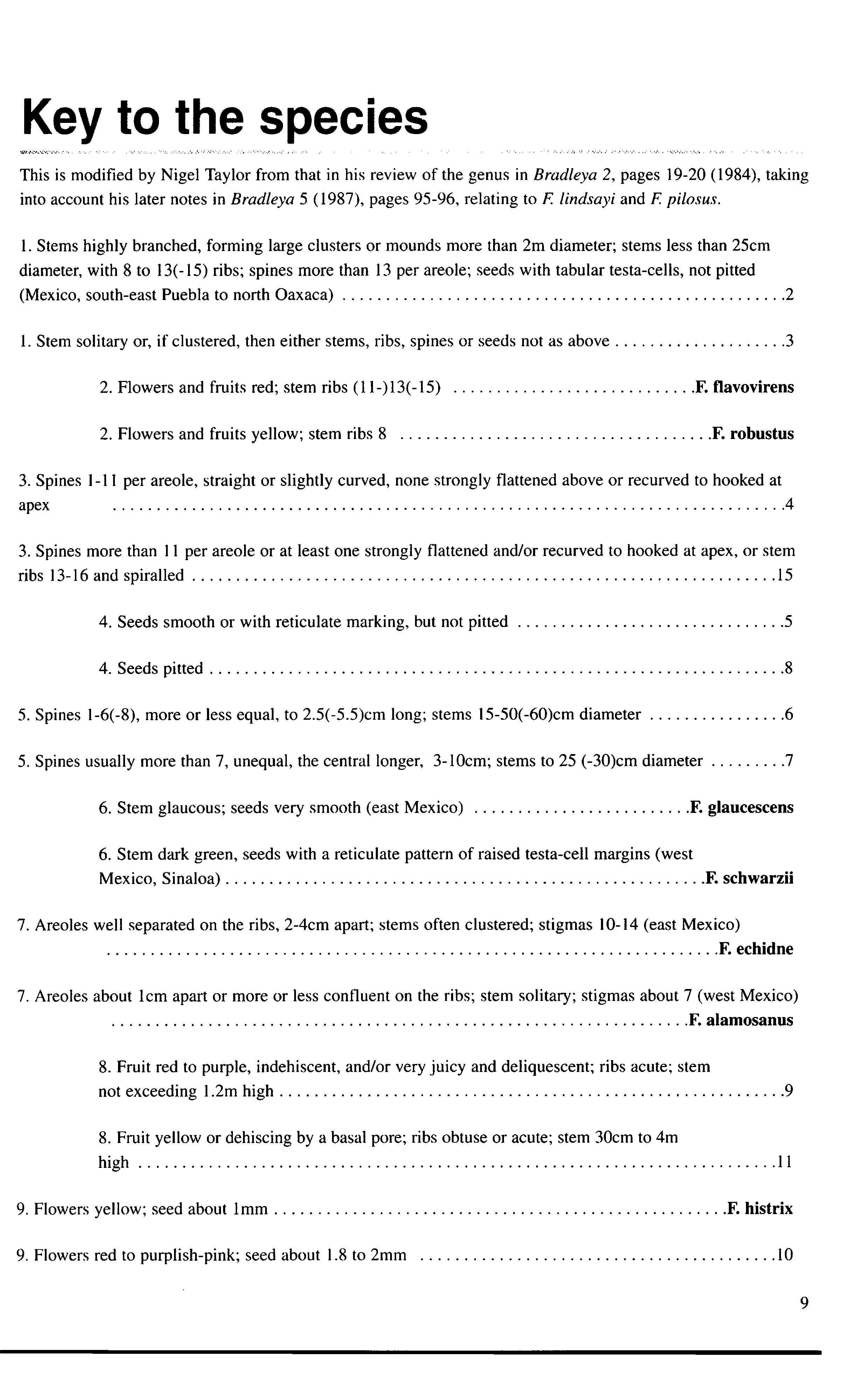
5. Spines usually more than 7, unequal, the central longer, 3-lOcm; stems to 25 (-30)cm diameter 7
6. Stem glaucous; seeds very smooth (east Mexico) F. glaucescens
6. Stem dark green, seeds with a reticulate pattern of raised testa-cell margins (west Mexico, Sinaloa) F. schwarzii
7. Areoles well separated on the ribs, 2-4cm apart; stems often clustered; stigmas 10-14 (east Mexico) ......................................................................F. echidne
7. Areoles about Icm apart or more or less confluent on the ribs; stem solitary; stigmas about 7 (west Mexico) ..................................................................F. alamosanus
8. Fruit red to purple, indehiscent, and/or very juicy and deliquescent; ribs acute; stem not exceeding 1.2m high
8. Fruit yellow or dehiscing by a basal pore; ribs obtuse or acute; stem 30cm to 4m high
9. Flowers yellow; seed about Imm
9. Flowers red to purplish-pink; seed about 1.8 to 2mm 9
11
F. histrix
10
10. Stem globular to cylindric, 30-120cm high; flower 6-7cm long o.. 0 00 00' .0.. of. haematacanthus 10. Stem depressed-globose, disc-shaped, to about 10cm high; flower 3-4cm long . · 0.000.. 00000.. 0 0.00.000.0.. 0.0.0.. 000..F. macrodiscus
11 . Central spine I per areole, conspicuous .. 0.00.. 000 0
11. Central spines 4 or not distinct from radials; seeds 1.5-2mm
12. Fruit red; seed 1mm, elongate-curved (Michoacan) 00.... 0.000.0.. 000.0.00.. of. lindsayi
12. Fruit yellow; seed 2-3mm, ovoid (north-west Mexico, south-west USA) .00.0.. 00.... 00.13
13. Flower to 4.5cm long; stem to 1m high (Mexico, south-west Chihuahua, south-east Sonora, north Sinaloa) ............ 0 0 0.0.00 .. 0 F. pottsii
13. Flower 6-7.5cm long; stem to 205m high (USA, south Arizona to Mexico, north Sinaloa, mainland Baja California Sur) 0.0.0 0.. 0.. 000.0 0.. 0 0 F. emoryi
14. Stem ribs about 13-20; spines usually red, some more or less flattened or angled, hairlike whitish spines often present; stems often in clumps (central northern Mexico) ................. 000000 00.000.0 .. 0.0.000.0 .. 00 00 o' 00.F. pilosus
14. Stem ribs 25-35; spines clear yellow, rarely reddish-brown, terete, all of one type; stem solitary (islands on west side of Gulf of California) F. diguetii
15. Scales on receptacle-tube and fruit with long narrowly attenuateapices (central north and south Mexico) ·.00.000.000 0 000.00.00.. 0 0 0..*F. latispinus
15. Scales not as above 00 16
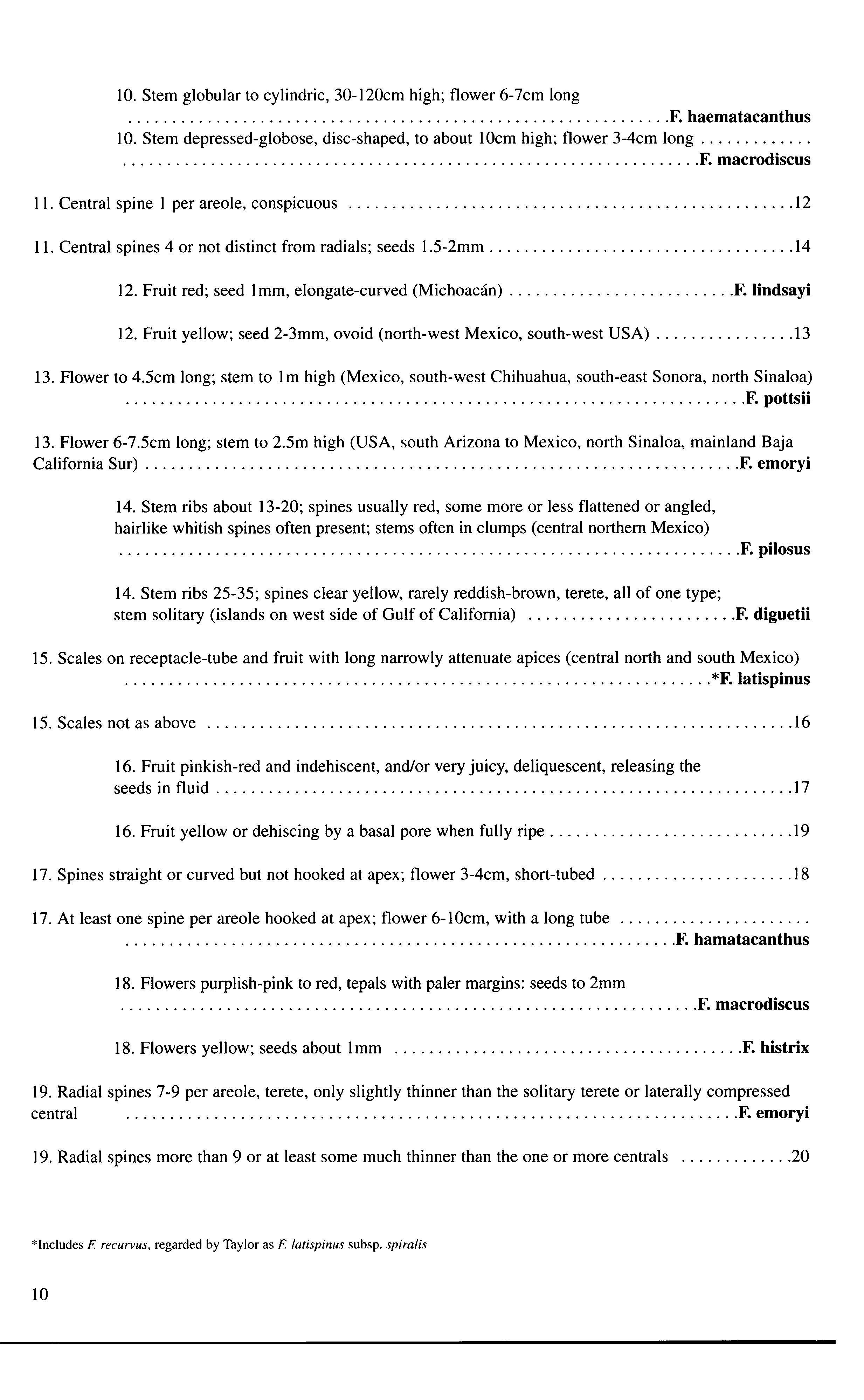
16. Fruit pinkish-red and indehiscent, and/or very juicy, deliquescent, releasing the seeds in fluid .. 0 0000 00000.. 0.. 000017
16. Fruit yellow or dehiscing by a basal pore when fully ripe. 0 0 0.00.. 000 19
17. Spines straight or curved but not hooked at apex; flower 3-4cm, short-tubed .. 0... 0.. 00.00.. 00000.18
17. At least one spine per areole hooked at apex; flower 6-1 Ocm, with a long tube 00 0.000.. 0 · 0 0 0.. 0..F. hamatacanthus
180 Flowers purplish-pink to red, tepals with paler margins: seeds to 2mm .0 000000000.000.000.0 0.0 o •• 00.. 00 F. macrodiscus
18. Flowers yellow; seeds about 1mm 0 0 0.. 00.0 0 0 F. histrix
19. Radial spines 7-9 per areole, terete, only slightly thinner than the solitary terete or laterally compressed central 0 00.000.00.0.. 0000of. emoryi
19. Radial spines more than 9 or at least some much thinner than the one or more centrals 20
*Inciudes F recurvus. regarded by Taylor as F /ati.\pinus subsp. spira/is
200 Perianth-segments remaining more or less erect at anthesis; flowers to 205cm diameter; stems often clustering, to 3m high; principal spines 6-12, none curved or hooked at apex, often accompanied by very fine hair-likeradials (central north Mexico) 000.000.00 ... 00.. of. pilosus
200 Perianth-segments spreading; flowers 3.5-6cm diameter, stems rarely clustering; spines not as above or centrals and radials intergrading (north-west Mexico and USA) o ••• 00.0.000... 021
21. Flowers violet-purple to lilac (Mexico, west coast of Baja California, Bahia Sebastian Viscaino to about 31 ° N) 0000.. 0.0 0.0.0 0 0.. 0 of. fordii
21. Flowers green, yellow, orange or red 00.. 00.0.. 000.0.0.. 0.0.. 0
22. Spines clearly differentiated into stout dark coloured centrals plus upper and lower radials, and finer whitish laterally directed radials, or the latter absent, and seeds with tabular testa-cells 0 0.0.. 0 00 00.0.22
0 23
22. Spines in each areole intergrading in size and colour; seeds with concave testa-cells 0000.. 0.00.000.0.. 0 000.0.. 0.. 0 25
23. Largest of the upward and downward directed central spines equally flattened and similar, curved but not normally hooked at apex, or fruits to 7.5cm long; flowers red (Mexico, Baja California 28-31° N) ............. 00.0 000 .. 00.0 00 0 00 .. 0 0 F. gracilis
23. Largest central spine more flattened than the others or otherwise dissimilar, often strongly recurved or hooked; flowers red to yellow; fruits to 6cm long .00.0.. 0.. 0 00.. 0 00.0 24
24. Seeds with tabular, finely verrucose, more or less isodiametric testa-cells, the raised anticlinal walls at the margin of each cell not prominent (south-west USA; Mexico, Chihuahua, Sonora, north Sinaloa, west Durango) 0.. 0 F. wislizeni
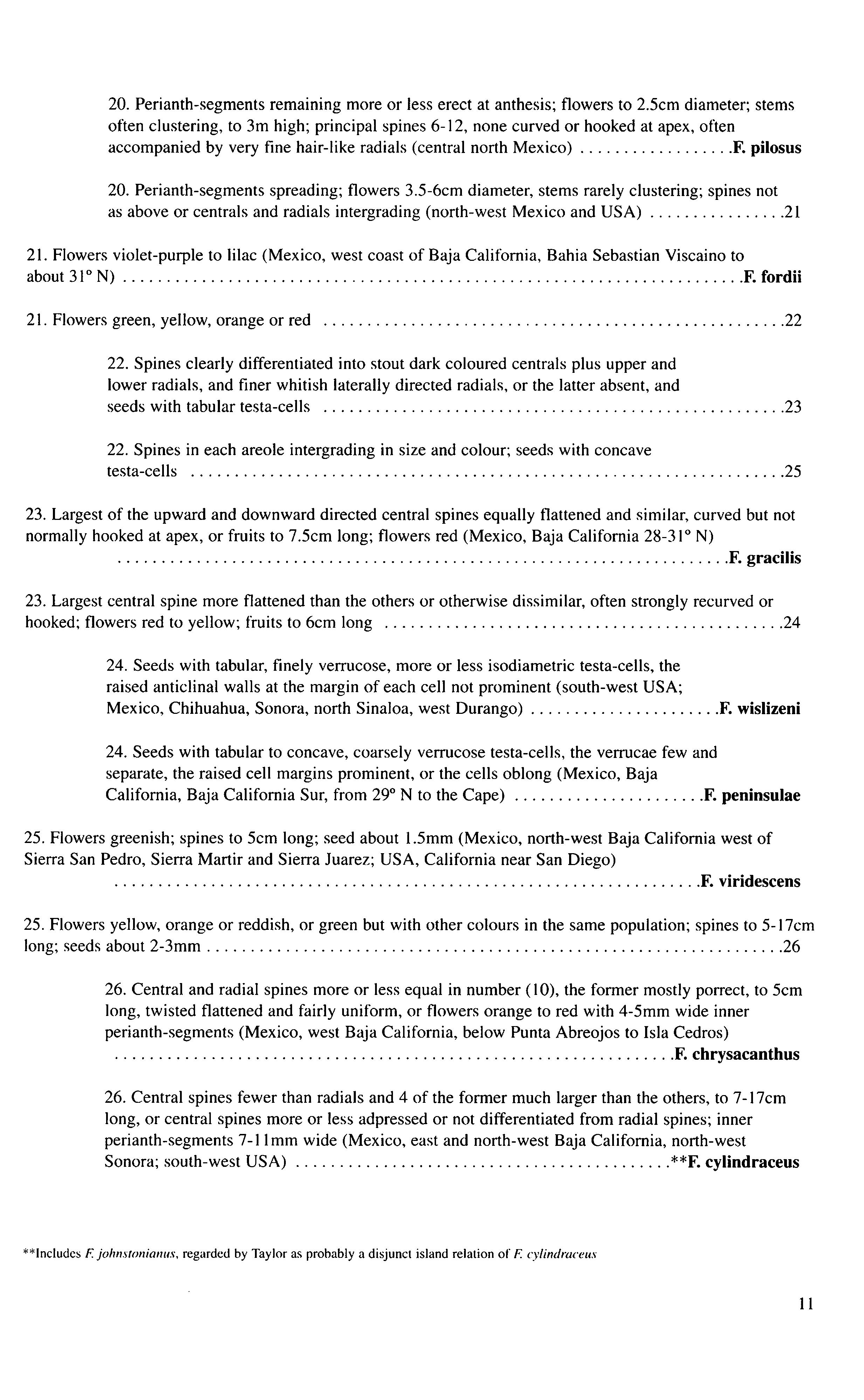
24. Seeds with tabular to concave, coarsely verrucose testa-cells, the verrucae few and separate, the raised cell margins prominent, or the cells oblong (Mexico, Baja California, Baja California Sur, from 29° N to the Cape) 0.00of. peninsulae
25. Flowers greenish; spines to 5cm long; seed about 1.5mm (Mexico, north-west Baja California west of Sierra San Pedro, Sierra Martir and Sierra Juarez; USA, California near San Diego) ........ 0 0 0 00.0.0 F. viridescens
25. Flowers yellow, orange or reddish, or green but with other colours in the same population; spines to 5-l7cm long; seeds about 2-3mm .0 0.0.. 0.0.0.. 000.0 0.. 0 00.. 00 26
26. Central and radial spines more or less equal in number (10), the former mostly porrect, to 5cm long, twisted flattened and fairly uniform, or flowers orange to red with 4-5mm wide inner perianth-segments (Mexico, west Baja California, below Punta Abreojos to Isla Cedros) ..... 00.00.00 0 00.0.. 00.. 00.0 F. chrysacanthus
26. Central spines fewer than radials and 4 of the former much larger than the others, to 7-17cm long, or central spines more or less adpressed or not differentiated from radial spines; inner perianth-segments 7-llmm wide (Mexico, east and north-west Baja California, north-west Sonora; south-west USA) o. 00.0.. 0 00.. 0.. 0.000.. 0 **F. cylindraceus
"*Includes F jolmstonianlls, regarded by Taylor as probably a disjunct island relation of F cylindraceus




